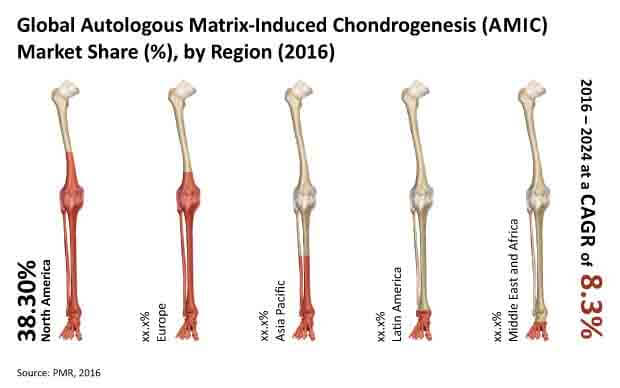Autologous Matrix-Induced Chondrogenesis Market Segmented By Hyaluronic Acid, Collagen, Polyethylene glycol, polylactic-co-glycolic acid Material Type
Industry: Healthcare
Published Date: November-2016
Format: PPT*, PDF, EXCEL
Delivery Timelines: Contact Sales
Number of Pages: 113
Report ID: PMRREP12271
Autologous Matrix-Induced Chondrogenesis (AMIC) is a biological treatment method to repair articular cartilage damage. AMIC therapy is a step-wise process. Micro fracture surgery is followed by application of a bi-layer collagen I/III membrane. It slows down cartilage degeneration with an intent to avoid or delay partial or total small joint replacement (e.g. knee replacement) surgery. The indications for AMIC includes Grade III or IV chondral lesions with lesion size of about 2 cm2 to 8cm2.
In this report we have categorized the AMIC treatment according to the material type used in the procedure that includes Hyaluronic Acid, Collagen, Polyethylene glycol, polylactic-co-glycolic acid and others. The category others also includes some of the accessorial material like PLLA, agarose-alginate, chitosan, poly (ester-ether) polydioxanone. The global Autologous Matrix-Induced Chondrogenesis market has been segmented on the basis of material type and regions.
The global Autologous Matrix-Induced Chondrogenesis market is projected to register a CAGR of 8.6% during the forecast period in terms of value. The Global Autologous Matrix-Induced Chondrogenesis market value in 2016 is estimated to be US$ 96.11 million and is expected to increase to US$ 186.4 million by the end of 2024.
Demand for minimally invasive surgeries has increased significantly in the past few years. Advantages such as fewer post-surgery complications and side effects, shorter patient recovery time, and decreased hospital stay are encouraging patients to opt for minimally invasive surgeries. Hence, rising demand for minimally invasive surgeries is expected to drive the autologous matrix-induced chondrogenesis market during the forecast period.
Autologous matrix-induced chondrogenesis is a one-step minimal invasive technique. Combined with microfracturing, it reduces the cost of microfracturing as compared to conventional microfacturing techniques and alternatives for treatment of chondral and osteochondral lesions. Hence, cost-efficiency of autologous matrix-induced chondrogenesis is likely to fuel the growth of the market in the next few years.
Musculoskeletal conditions are a major burden on individuals, health care systems, and social care systems, with indirect costs being predominant. According to the World Health Organization, people aged 45 years and above in the U.S. and Europe show higher rates of osteoarthritis; 14.1% among men and 22.8% among women. Hence, growing prevalence of bone and joint disorders is likely to fuel the growth of the autologous matrix-induced chondrogenesis market in the near future.
Most of the countries have less or no reimbursement for autologous matrix-induced chondrogenesis products or procedures. Autologous matrix-induced chondrogenesis products or procedures are not reimbursed by several health insurance companies in Europe. There is no reimbursement in most of the developing countries such as India, Australia, and Brazil. Hence, lack of efficient reimbursement is likely to hamper the growth of the autologous matrix-induced chondrogenesis market during the forecast period.
Autologous matrix-induced chondrogenesis is a recent technique, and hence does not have extensive clinical data. This is restraining physicians/doctors from adopting autologous matrix-induced chondrogenesis methods for treating patients suffering from bone and joint disorders. Hence, lack of extensive clinical data is likely to hamper the growth of the autologous matrix-induced chondrogenesis market in the next few years.
Based on material type, the market has been segmented into Hyaluronic Acid, Collagen, Polyethylene glycol, polylactic-co-glycolic acid and others. The collagen segment held a major market share of 51.8% in 2015 due to high tensile strength and excellent handling properties.
The hyaluronic acid segment is estimated to account for 22.6% of the global market in 2016 and is likely to register a CAGR of 8.9% during the forecast period. The PEG segment is projected to register a high CAGR of 11.1% during the forecast period due to their ability to be gelled into complex defects in situ using UV-light.
The global Autologous Matrix-Induced Chondrogenesis market has been segmented into five major regions: North America, Latin America, Europe, Asia Pacific (APAC), and Middle East & Africa (MEA).
In terms of value, North America is estimated to be the dominant market for global Autologous Matrix-Induced Chondrogenesis market in 2016 and expected to witness a CAGR of 8.3% over the forecast period. APAC is estimated to be the fastest growing markets in terms of CAGR. PEG segment in the North America Autologous Matrix-Induced Chondrogenesis market is expected to register a CAGR of 11.3% over the forecast period.

Some key players in the global Autologous Matrix-Induced Chondrogenesis market identified in this report are Anika Therapeutics, Inc., Arthro-Kinetics, B. Braun Melsungen AG, BioTissue AG, CartiHeal, Geistlich Pharma AG, JRI Orthopaedics Ltd., Matricel GmbH, Smith & Nephew plc, and Zimmer Biomet Holdings. The report also identifies company-specific strategies related to product development; market consolidation initiatives and analysis of their specific strengths, weaknesses, opportunities, and threats.
The global Autologous Matrix-Induced Chondrogenesis market is largely consolidated, with top ten players accounting for around 70.0% share in 2015. Market players such as Geistlich Pharma AG, Zimmer Biomet Holding, Smith & Nephew plc, B. Braun Melsungen AG, and Anika Therapeutics, Inc. dominated the global market in 2015.
The company share of Geistlich Pharma AG in 2015 was valued at around 21%, thereby dominating the global Autologous Matrix-Induced Chondrogenesis market. Zimmer Biotech Holdings accounted for 13.5% market share in 2015, thereby holding the second largest market share followed by other players like Smith & Nephew plc, B. Braun Melsungen AG, and Anika Therapeutics, Inc.
|
By Material |
|
|
By Region |
|
To know more about delivery timeline for this report Contact Sales
